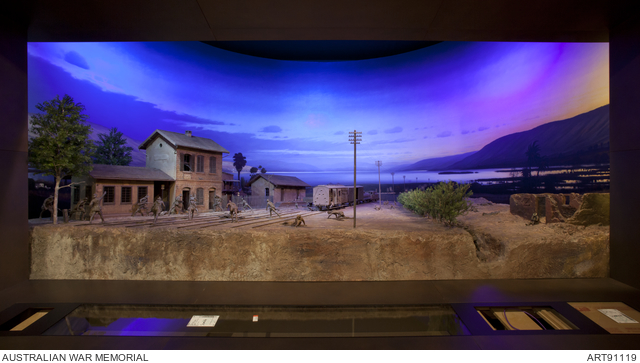| Place | Middle East: Ottoman Empire, Palestine, North Palestine, Lake Tiberias, Semakh |
|---|---|
| Accession Number | ART91119 |
| Collection type | Art |
| Measurement | Overall: base: 444 x 370 cm; height of largest figure: 20 cm; height of smallest figure: 2 cm; background: 300 x 1000 cm |
| Object type | Diorama |
| Physical description | figures: pewter (tin, antimony and zinc) with [paint]; modelling: plaster over wood and wire with wire, metal and [paint]; background: oil on canvas on timber and metal support |
| Location | Main Bld: First World War Gallery: Sinai Palestine 1918: Semakh |
| Maker |
Anderson, Wallace McCubbin, Louis Frederick McKenzie, Alexander |
| Place made | Australia: Victoria, Melbourne, Australia: Victoria, Melbourne |
| Date made | 1926–27; 2013 |
| Conflict |
First World War, 1914-1918 |
| Copyright |
Item copyright: © Australian War Memorial This item is licensed under CC BY-NC
This item is licensed under CC BY-NC
|
Semakh



On 25 September 1918, Semakh was the scene of a short action between Australian light horsemen and a mixed force of Turks and Germans. Located at the southern end of Lake Tiberias (the Sea of Galilee), Semakh was significant due to its position on the Damascus railway line. The Germans had added machine-gunners to the small Turkish garrison and command was entrusted to a German officer.
The 4th Light Horse Brigade, under Brigadier General William Grant, was sent to capture Semakh. As they approached the south of Semakh just before dawn on 25 September, the forward troops were heavily fired upon. The Australian troops charged the town, with two squadrons of the 11th Light Horse Regiment attacking the eastern end of Semakh and two squadrons of the 12th Light Horse Regiment attacking the western end. The town was captured by 0530 and 365 prisoners taken - half of them German.
As part of the Australian War Memorial's First World War Gallery redevelopment, artist Alexander McKenzie (b. 1971) was commissioned in 2013 to produce a new background for the Semakh diorama. McKenzie travelled to the site of Semakh to observe the scale of the landscape and get a sense of the atmosphere at dawn.